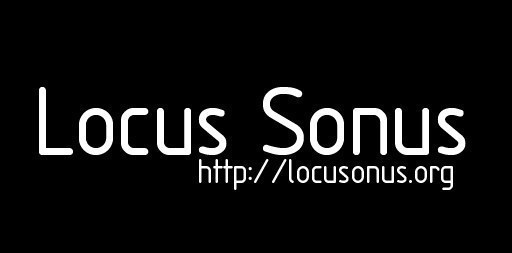|
symposium #5
mar2009
Audio Connect ?
LOCUS SONUS audio in art
http://locusonus.org/
du 3 au 5 mars 2009
École Supérieure d'Art d'Aix en Provence
http://www.ecole-art-aix.fr/
MMSH - Maison Méditerranéenne des Sciences de l'Homme
http://www.mmsh.univ-aix.fr/
|
menu
|
participants
| |
|
Jérôme Joy
 |
Présentation / Lecture
Networked Music and SoundArt Timeline : a panoramic view of practices related to sound transmission and distance
This timeline aims to provide an overview of the principal events and projects in the realm of networked music and networked sonic performance since the beginning of the XX° century. The objective of this project is to reveal or uncover links between disciplines often considered separately such as art/music, technological development, social shifts, anticipationary visions & proleptic statements. This will in turn provide a clearer vision of the very recent history of soundart and music in todays networked technological environment. The current iteration was in launched 2008 within the context of the Locus Sonus research lab one of whichs vocations is to provide a corpus of information for documentary and critical use available to researchers, artistes and the arteducation community in general. It is nourished by parallel research, developed in recent years within Locus Sonus, concerning remote sound recording and playback, live audio streaming, and ‘geotagged’ sound projects.
Historique de l'art audio et de la musique en réseau : panorama des pratiques et techniques liées aux transports de sons et aux actions sonores à distance, comme nouveau paradigme de l'écoute
Ce Timeline vise à fournir une vue d’ensemble des événements et projets artistiques principaux dans les domaines de la musique et de la performance sonore en réseau depuis le début du XXème siècle. La forme générale du Timeline est une structure de base de données. L’objectif de ce projet est de révéler et de découvrir des liens et des croisements entre des disciplines le plus souvent observées séparément, telles que art et musique, les sciences et technologies, les modifications sociales et observations sociologiques, les approches philosophiques, et des états visionnaires et proleptiques présents dans ces domaines et dans la littérature d’anticipation. En retour, ceci donnera une vision plus claire de l’histoire récente de l’art sonore et en musique dans le contexte actuel des environnements technologiques en réseau. Le présent document a été lancé en 2008 dans le contexte du laboratoire de recherche Locus Sonus dont une des vocations est de fournir un corpus critique voire théorique de ressources pour une utilisation documentaire par les chercheurs, les artistes et la communauté de l’enseignement artistique. Il est nourri par des études menées en accompagnement des projets de réalisation du laboratoire, développés ces dernières années, notamment à propos du “remote sound recording” (enregistrement et prise de son à distance), du live audio streaming (transports de sons en direct via Internet) et des projets sonores géo-taggés et impliqués dans la géo-localisation (les cartes sonores ou soundmaps).
pdf presentation (download)
→ url
back to programme
Jérôme Joy is a composer and networks artist who has been teaching since 1992 at the National School of Arts, Villa Arson Nice and since 2004 as research director with Peter Sinclair of the research group Locus Sonus - Audio in Art. Having delivered multiple performances of both instrumental and electro-acoustic music since the early 1980s, he has devised numerous international networked projects and collectives (in music, sound and net) since 1995. His interests encompass the vast realm of sound composition, alighting upon and inspired by electronic production, programming technologies, networked systems, shared databases and the interplay and local gaps of narration into our daily life and social contexts. He's continuously working on various projects : Sobralasolas !, nocinema, picNIC, Collective JukeBox, etc.
Compositeur et artiste-enseignant à l'École Nationale Supérieure d'Art de Nice Villa Arson depuis 1992, Jérôme Joy coordonne le laboratoire de recherche 3ème cycle Locus Sonus audio in art avec Peter Sinclair et Anne Roquigny. Après un parcours de performances et de concerts instrumentaux et électroacoustiques à partir de 1982, il développe depuis 1995 de nombreux projets en réseau (concerts, database sonore participative, musique électronique, radiophonie, cinéma et performances). Ses projets et concerts, personnels ou en collectif, sont présentés dans de nombreux festivals, colloques et événements internationaux. Ses dernières réalisations sont tournées vers les réseaux et la radiophonie - Collective JukeBox, picNIC, nocinema.org, PacJap, pizMO, Lib_, Sobralasolas ! -.
|
| |
--> http://jeromejoy.org
--> http://nocinema.org
--> http://locusonus.org/
|
| |
|
Kazuhiro Jo

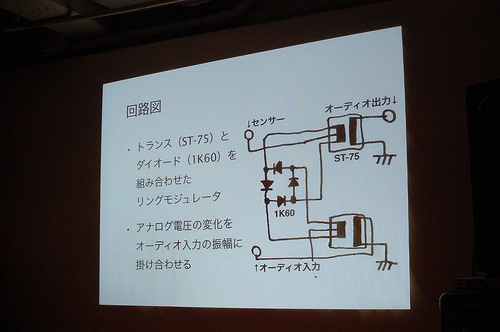 |
Présentation / Lecture / Performance
• Talk Part 1: Current state of Digital Media, Culture Lab, Newcastle University
In first part of my talk, I would like to talk about our current state of Digital Media, Culture Lab, Newcastle University. We presents our latest projects, we-create, Dry Run, and Chiptune Music Band. I also briefly refer to our current PhD Research lead by students.
• Talk Part 2: The Music One Participates: From Practices of The SINE WAVE ORCHESTRA
In second part of my talk, I would like to talk about my idea of the music one participates based on our continuous practices of a participatory sound performance project "The SINE WAVE ORCHESTRA". This talk is based on a recent published paper [Jo et al, 2008].
• Performance: Lighting Wave / Colored Noise
In my performance, I will show two contrastive instruments “Lighting Wave” with photosensitive sine wave objects coming from The SINE WAVE ORCHESTRA and Colored Noise with an isolated white noise generator.
pdf presentation (download)
back to programme
Kazuhiro Jo is a Japanese sound artist and researcher with background in acoustic design and in interaction design educated at Kyushu Institute of Design and the University of Tokyo. He is currently working as a Research Fellow at Digital Media, Culture Lab, Newcastle University. He is also a member of a participatory sound performance project The SINE WAVE ORCHESTRA, an image sound processing software platform Monalisa, an auditory design performance project AEO, and a co-organizer of dorkbot Tokyo. He has been awarded grants and support from Prix Ars Electronica, IPA Exploratory Software Project, and Japanese Government Overseas Study Program for Artists.
|
| |
--> http://www.ncl.ac.uk/culturelab/
--> http://swo.jp/
--> http://monalisa-au.org/plog/
--> http://dorkbot.org/dorkbottokyo/ |
| |
|
Peter Tomaz Dobrila
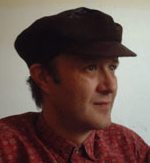 |
Présentation / Lecture
Famous Australian artist Stelarc has said for KIBLA "this is the best cyber space in the world", the great Eduardo Kac, who works at the Art Institute of Chicago, "something like this doesn't exist in United States" and Joseph Tabby, university professor and writer, "I came to visit Slovenia, because I've heard about KIBLA". A title in Slovenian magazine Mladina: "To Maribor, because of KIBLA!" and in NeDelo (the biggest Slovenian newspaper, Sunday issue) Eda ufer wrote: "Maribor Kibla is by its space possibilities and its conceptual structure, that combines gallery, spaces for performance, specialised bookshop and cyber café undoubtedly the most exemplary project of a kind".
KIBLA Multimedia Center is the first presentation and production institution in Slovenia dealing with multimedia and intermedia art and a yearlong cultural programme. We still incorporate pure classical media but in a different context – we use them to support historical continuity of visual art and a bigger aesthetization and integration of electronic media. We support principles that lead to complex systems of multimedia presentation. We also produce and co-produce cultural artistic projects and publish presentation materials. KIBLA comprises artist studios, screening and exhibition spaces.
pdf presentation (download)
back to programme
Peter Tomaz Dobrila is a musician and an electronic and IT engineer who focuses on the creative use of the new technologies. In 1996 he co-founded the Multimedia Center KiberSRCeLab – KIBLA (MMC KIBLA), Maribor. Two years later he co-founded the Association for Culture and Education KIBLA (ACE KIBLA) and became its president. He managed MMC KIBLA and ACE KIBLA until 2004. Since then he has participated in numerous congresses and conventions on internet and multimedia and information culture. He acts as consultant and advisor in cultural matters and is a fellow of the European Academy for Digital Media (EADIM).
|
| |
--> http://www.kibla.org
|
| |
|
Scott Fitzgerald
 |
Présentation / Lecture (via Skype)
When working in a collaboration, with a group, we have the potential
to harness the collective intelligence of the group. This is best
exemplified through the internet and its sprawling, node-based
connections, where everyone is a specialist on at least one thing.
Technology allows us to leverage these connections for realtime
information exchange. With an increase in affordable portable
computing technology (smart phones, embedded devices, etc.), we can
become aware of our environments, and broadcast information about our
location, in an immediate and real way. These devices also generate
information and data that we never consciously use, but are still a
valid set of data points. Through identifying and interpreting
patterns in data streams obtained from a number of localized devices,
we can construct a detail-rich portrait of an environment that we can
examine from a number of different perspectives.
pdf presentation (download)
back to programme
Scott Fitzgerald is an artist, educator and technologist, currently member of the Locus Sonus Lab. He builds tools for himself and others to express themselves in unique and idiosyncratic fashions. He holds a Masters degree from New York University's Interactive Telecommunications Program (NYU ITP), and has a variety of previous experiences as a social worker, documentary filmmaker, and radio DJ.
At NYU, Scott has taught Physical Computing, Video for New Media, and Expanding Interactive Video for the last several years, working with students to expand their interactions with machines, and explore the boundaries of video installation and performance.
Scott Fitzgerald est artiste, enseignant et chercheur américain, actuellement membre du laboratoire Locus Sonus.
Il invente et fabrique des outils technologiques, des programmes, des logiciels
et des circuits électroniques dédiés et sur mesure pour ses propres projets et pour ceux qu'il développe avec d'autres artistes et collaborateurs. Il est diplômé du Département ITP, (InteractiveTelecommunications Program) de l'Université de New York NYU, il a aussi une expérience de travailleur social, de réalisateur de documentaires et de DJ pour la radio. Il a dispensé des cours de robotique et de programmation dans des Écoles Supérieures et il enseigne depuis plusieurs années les sciences physiques, la vidéo et les nouveaux média à la NYU .
|
| |
--> http://ennuigo.com/
|
| |
|
Pedro Rebelo
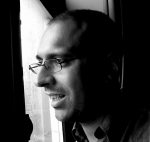
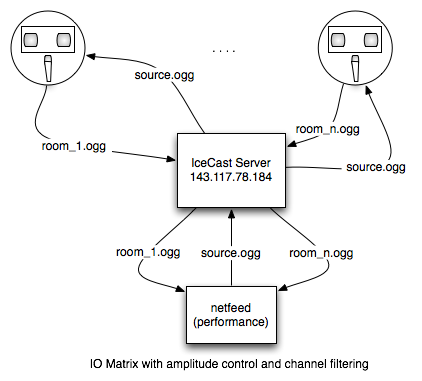 |
Présentation / Lecture / Performance
• Addressing the Network: Performative Strategies for Playing APART
The presentation will refer to research conducted in the context of the Comedia EU Culture 2007 project at the Sonic Arts Research Centre. Notions of network dramaturgy are explored with a view to develop an understanding of the types of performative engagement in the network. This paper addresses challenges and opportunities posed by the design and production of network performance from the point of view of collaborative creative work. It does so by examining strategies that, while referring to the network as a new medium for performance, make use of concepts from dramaturgy to better understand the relationships between artists, audiences and media. The author characterises three distinct models for dramaturgy, particularly from the point of view of collaboration, authorship, presence and environment. Pedro will draw on examples from the performances of Disparate Bodies and Netrooms in order to illustrate current practice that addresses network dramaturgy.
• Netrooms : a long feedback
Netrooms: The Long Feedback is a participative network piece which invites the public to contribute to an extended feedback loop and delay line across the internet. The work explores the juxtaposition of multiple spaces as the acoustic, the social and the personal environment becomes permanently networked. The performance consists of live manipulation of multiple real-time streams from different locations which receive a common sound source. Netrooms celebrates the private acoustic environment as defined by the space between one audio input (microphone) and output (loudspeaker). The performance of the piece consists of live mixing a feedback loop with the signals from each stream.
pdf presentation (download)
back to programme
Pedro Rebelo is a composer/digital artist working in electroacoustic music, digital media and installation. His approach to music making is informed by the use of improvisation and interdisciplinary structures. He has been involved in several collaborative projects with visual artists and has created a large body of work exploring the relationships between architecture and music in creating interactive performance and installation environments. This includes a series of commissioned pieces for soloists and live-electronics which take as a basis the interpretation of specific acoustic spaces.
In the duo laut with saxophonist Franziska Schroeder he investigates the extension of interfaces and control in interactive performance practices. His electroacoustic music is featured in various CD sets (Sonic Circuits IV, Discontact III, Exploratory Music from Portugal, ARiADA). His work as an improvisor has been released by Creative Source Recordings. Pedro conducts research in the field of digital media, interactive sound and composition.
His writings reflect his approach to design and composition by articulating creative practice in a wider understanding of cultural theory. Pedro was Visiting Professor at Stanford University (2007) and the Music Chair for the 2008 International Computer Music Conference. He has been Director of Research at the Sonic Arts Research Centre and is now Director of Education at the School of Music and Sonic Arts, Queen’s University Belfast.
|
| |
--> http://www.sarc.qub.ac.uk/
--> http://www.sarc.qub.ac.uk/%7Eprebelo/netrooms/ |
| |
|
Samuel Bordreuil
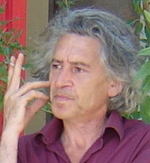 |
Présentation / Lecture
Une Dacia musicale :
En apparence le projet « Road Music » que pr&eacutre;sentera Peter Sinclair, et sur lequel je me propose de rebondir, n’a que peu à voir avec les expérimentations du type « connected sonic space ». Cela ne l’empêche pourtant pas de décliner à sa façon le même thème qui est celui de générations et/ou créations sonores travaillant, explorant leurs dimensions spatiales.
La visée du propos sera alors d’exploiter le caractère transversal du dispositif monté par Peter Sinclair, par rapport aux autres expérimentations pour mieux revenir sur certains des problèmes qui s’y posent et/ou des difficultés qui s’y rencontrent.
En particulier on tentera de faire valoir qu’une voie s’y esquisse, à mi-distance entre, d’un côté, écoute (infiniment) patiente du monde et (du moindre) de ses bruissements et impatience compositrice (et comme telle délocalisante). Peut-être celle de nouvelles écologies musiciennes.
pdf presentation (download)
back to programme
Interventions précédentes et récentes / Previous and recent lectures
 écoute/listen mp3 Audio Extranautes (symposium 4 Audio Extranautes, 2007) écoute/listen mp3 Audio Extranautes (symposium 4 Audio Extranautes, 2007)
 écoute/listen mp3 Faire paysage: Landscaping versus scape landing (symposium 3 Audio Sites, nov 2006) écoute/listen mp3 Faire paysage: Landscaping versus scape landing (symposium 3 Audio Sites, nov 2006)
 écoute/listen mp3 Dog poop girl (université FING, juin 2006) écoute/listen mp3 Dog poop girl (université FING, juin 2006)  (pdf) (pdf)
Sociologue, Directeur de Recherche au CNRS, Directeur du LAMES (Laboratoire Méditerranéen de Sociologie) à la MMSH d'Aix-en-Provence.
Ses recherches portent principalement sur la dimension publique de la vie sociale, telle qu'elle s'incarne dans les espaces urbains, qu'elle se développe en sphères de débats (publics), qu'elle se manifeste au travers de mobilisations collectives (construction de publics). Dans ce cadre il porte une attention particulière aux nouveaux espaces et régimes de publicité portées par l'expansion des technologies du numérique.
Publications récentes / recent writings :
- L'histoire de la 'Dog Poop Girl' revisitée : usages et mésusages d'un médium hétérotopique, in Réseaux, numéro spécial sur les blogs, automne 2006.
- A l'orée du monde, le monde, conférence donnée dans le cadre des journées sur "mobilités et mondialisation", décembre 2003, organisées par Dana Diminescu, MSH Paris et Anne Marie Morice, Synesthesie.com.
Texte et vidéo accessibles sur www.msh-paris.fr et sur le site de Synesthésie.
Il a publié en 2007 dans Libération un article remarqué sur la Nouvelle-Orléans.
Contributions antérieures à des ouvrages collectifs :
La Ville desserrée, in "La ville, l'urbain : l'état des savoirs", Éditions de la Découverte, Paris (2000).
Anatomie d'une émeute inter ethnique : Crown Heights, New York, 19 août 1991, in "Les juifs et la ville", Presses Universitaires du Mirail, Toulouse (2000).
Samuel Bordreuil is Senior Research Scientist, Centre National de la Recherche Scientifique (CNRS). Director of Laboratoire Méditerranéen of Sociology (LAMES) [Mediterranean Center for Sociology], Maison Méditerranéenne des Sciences de l'Homme (MMSH), Aix en Provence.
Areas of research:
Urban sociology, micro sociology of public space, in particular:
- Physical space, social space: the "sense of place"
- Territories and democracy
- Public dimensions of new ITC and their usages
- Artistic engagement and the construction of publics.
|
| |
--> http://www.mmsh.univ-aix.fr/lames/
--> http://www.imageson.org/
--> http://www.openfing.org/upfing06/
--> http://www.synesthesie.com/mobilites/
--> http://www.liberation.fr/opinions/rebonds/ |
| |
|
Jean-Paul Thibaud
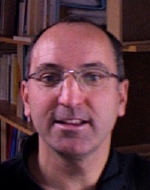 |
Présentation / Lecture
"Les quasi-présences de l'écoute au casque"
Cette intervention se saisira des pratiques et perceptions des auditeurs-baladeurs en espaces publics pour questionner le rapport entre son et
espace. L’écoute au casque sera un moyen de montrer comment des habitudes perceptives et des modes de présence sonore aux lieux peuvent se déstabiliser et révéler alors de nouvelles manières d’être plus hybrides, instables et
singulières.
pdf presentation (download)
back to programme
Interventions précédentes/ Previous lectures
 écoute/listen mp3 Audio Extranautes (symposium 4 Audio Extranautes, 2007) écoute/listen mp3 Audio Extranautes (symposium 4 Audio Extranautes, 2007)
 conférence/lecture pdf Notes pour une grammaire générative des ambiances urbaines (symposium 4 Audio Extranautes, 2007) conférence/lecture pdf Notes pour une grammaire générative des ambiances urbaines (symposium 4 Audio Extranautes, 2007)
Jean-Paul Thibaud, sociologue et urbaniste, est directeur de recherche au CNRS. Chercheur au Cresson (Centre de Recherche sur l'Espace Sonore et l'Environnement Urbain, Umr 1563 "Ambiances Architecturales et Urbaines"). Son domaine de recherche porte sur la théorie des ambiances urbaines, la perception ordinaire en milieu urbain, la culture et l'ethnographie sensibles des espaces publics. Il est responsable scientifique du Réseau International Ambiance(s).
Quelques références bibliographiques :
- Grosjean, M., Thibaud, J.P. (Eds.) L'espace urbain en méthodes. Marseille : Parenthèses, 2001
- Amphoux, P., Thibaud, J.P., Chelkoff, G. (Eds.) Ambiances en débats. Bernin : A la Croisée, 2004
- Thibaud, J.P. De la qualité diffuse aux ambiances situées. In Raisons Pratiques. n.15 "La croyance et l'enquête", sous la direction de B. Karsenti et L. Quéré, Paris : Éditions de l'EHESS, 2004, pp. 227-253
Laboratoire Cresson :
Group of enactivists working at the Cresson Lab, they aim at putting into context interdisciplinary questioning at the crossroad of architecture, social studies and engineering sciences. The concept of 'ambiance' (atmosphere) leads at once to physical and cultural phenomena. They uses it as a basic tool to make in situ experiments in order to question the interactions and the inter-relationships that a place and its caracteristics maintains with perception and public imagery.
|
| |
--> http://www.cresson.archi.fr/
--> http://www.cresson.archi.fr/PUBouvAMBIANCES.htm
--> http://www.cresson.archi.fr/AMBIANCE2008.htm
|
| |
|
Gabriel Bérubé
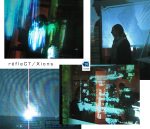 |
Présentation / Lecture
Diversion, une expérience sonore en espace public urbain
Au quotidien, le citadin déambule et chemine dans l’espace public en appréhendant son environnement à l’aide de ses sens. C’est par cette expérience sensorielle qu’il perçoit et se construit une ambiance. Il sera question ici de l’aborder sous l’angle de l’expérience subjective vécue par les citadins. Nous interrogerons alors directement, dans ces actions journalières, l’usager sur la perception qu’il aura de son environnement. Nous concentrerons notre analyse particulièrement sur l’expérience sonore vécue par l’usager afin de mieux comprendre la manière dont il interprète cette matière sonore. Pour ce faire nous croyons que le projet de recherche création est la meilleure voie d’accès à l’obtention de résultats novateurs. L’installation « Diversion » présentée dans ce travail, devient donc une sorte de catalyseur afin de mettre à jour certaines dimensions jusqu’ici moins bien explorées. Le dispositif artistique ainsi mis en place, par de subtiles transformations des sons perçus, engendre une prise de conscience de l’usager de la présence de son propre corps dans l’espace et, de la relation active et singulière qui s’opère alors. Suite à la captation et à la modification de la nature des sons produits par l’usager, ils sont retransmis en temps réel dans l’espace afin de rendre extraordinaire une expérience ordinaire.
pdf presentation (download)
back to programme
Doctorant en architecture, laboratoire de recherche Cresson, École Nationale Supérieure d’Architecture de Grenoble (septembre 2008).
Maîtrise en aménagement, option design et complexité, Université de Montréal (2008).
Baccalauréat en architecture de paysage, Université de Montréal (2005).
Recherches actuelles : expérience sensible de l’usager dans l’espace public et design urbain.
|
| |
--> http://www.cresson.archi.fr/
--> http://www.cresson.archi.fr/PUBouvAMBIANCES.htm
--> http://www.cresson.archi.fr/AMBIANCE2008.htm
|
| |
|
Patrick Romieu
 |
Présentation / Lecture
Le Mort en ses espaces sonores
La visée anthropologique des expé́riences sonores se doit de consideérer l’effet matriciel des dispositifs convoqué́s par l’action collective en espace public. Dans le cas de dispositifs engageant fortement l’expé́rience corporelle en diffeérentes modaliteés sensorielles le son devient une modalité́ parmi d’autres, veéhiculant sa logique propre dans la configuration de l’espace sensible, en interaction avec les autres donneées expé́rientielles.
pdf presentation (download)
back to programme
Je commence mes recherches anthropologiques à l’Université de Provence dans le laboratoire CREHOP alors dirigé par Jean-Claude Bouvier (1979-1982). Mon travail porte sur l’oralité et les ethnotextes. Après une expérience dans l’Enseignement et la Formation pour Adultes je retourne à la recherche pour m’inteéresser à l’anthropologie sonore. Je conduis une thèse sous la direction de Jean-François Augoyard, au laboratoire CRESSON, thèse qui sera soutenue à l’automne 2009.
Mon travail questionne l’Expérience sonore collective dans ses fondements anthropologiques représentées par des dispositifs de fête de pays, en Haute-Provence. Parallèlement j’investis un autre axe de recherche concernant les ambiances sonores extrêmes comme celles de la guerre ; ce travail ne fait que commencer.
J’anime enfin une Association loi 1901 - Archimeda - qui conduit depuis dix ans un travail de Formation et de Sensibilisation sur des questions d’Écologie sonore ; entre autres choses: Promenades d’Écoute à Aix en Provence, Digne-les-Bains ; organisation de la Semaine du Son depuis trois ans à Digne; nombreuses conférences sur l’Anthropologie et l’Écologie sonore ; formation
pour la FAI AR de Michel Crespin en compagnie de Michel Risse ; en 2006, organisation des États Généraux du Son en qualité de Commissaire ; projet en cours d’une École des Paysages et Climats sonores.
|
| |
--> http://www.cresson.archi.fr/
--> http://www.cresson.archi.fr/PUBouvAMBIANCES.htm
--> http://www.cresson.archi.fr/AMBIANCE2008.htm
|
| |
|
Peter Sinclair
 |
Présentation / Lecture
LSinSL & New Atlantis : Locus Sonus exploring audio possibilities of virtual spaces.
Generally speaking LS is concerned with the innovative & transdisciplinary nature of audio art. We explore these areas in a group context, within which we aim to evaluate the groups own projects & realizations, however we also have a tendency to provide openings for other artists & researchers. An important aspect of our research centers on the exploration of multi user systems and requires by definition collective collaboration. Our research is englobed by two main themes - audio in it's relation to space and networked audio.
Locus Sonus decided along with the art and technology department at SAIC, to create a multi user virtual world based on the second life model, but entirely dedicated to audio experimentation.
Like Second Life or many online video games each user or visiter will download an application which will render the world locally on their computer. Each copy of the world is linked to a server so each user can perceive the actions of other users online. The principal difference between the proposed world and second life is that it will incorporate relatively sophisticated audio processing possibilities and that the navigation, architecture & esthetics are to be thought out primarily to enhance the listening experience.
pdf presentation (download)
back to programme
Interventions précédentes et récentes / Previous and recent lectures
 écoute/listen mp3 Audio Extranautes (symposium 3 Audio Sites, 2006) écoute/listen mp3 Audio Extranautes (symposium 3 Audio Sites, 2006)
Peter Sinclair is a digital media and sound artist. He is tenured professor at Ecole Superieure d'Art d'Aix-en-Provence where he has been responsible for the sound department since 1996. He is also currently a member of the scientific council for research and studies at the DAP (fine arts department) of the French Ministry for Culture and research co-director with Jérôme Joy of Locus Sonus lab audio in art, which is a collaboration between two Schools of Arts, ESA Aix-en-P and ENSA Nice Villa Arson, and the sociology laboratory LAMES CNRS-MMSH. Peter Sinclair is known for his sound installations and other cross-disciplinary works which use sound as their principal medium. Excited by technology but handling it with critical irony, his work has moved from burlesque mechanics, through the misuse of computers to performance that parodies modern media language in transatlantic streamed-collaborations. Aside from his personal artistic productions Peter Sinclair participates in various collectives as "PacJap" and "Daisy Chain" and he has been working with New-York based artist GH Hovagymian since 1996.
Peter Sinclair est un artiste principalement connu pour ses installations sonores et ses réalisations utilisant l'audio comme principal médium. Engagé dans des pratiques artistiques liées aux technologies il manipule ces médiums avec un regard critique, parfois ironique, mettant en oeuvre des rencontres entre hommes et machines pour créer des situations inédites. Son travail évolue de la mécanique burlesque, en passant par le détournement d'ordinateurs, jusqu'à la performance - son oeuvre parodie le langage des media modernes via des collaborations en réseau. Il enseigne à l'École Supérieure d'Art d'Aix-en-Provence où il est responsable du département son depuis 1996. Il est aussi membre du Conseil Scientifique du Bureau de la Recherche et de l'Innovation de la Délégation aux Arts Plastiques du Ministère de la Culture et co-dirige avec Jérôme Joy le laboratoire de recherche et cursus 3ème cycle Locus Sonus audio in art.
|
| |
--> http://petersinclair.org/
--> http://nujus.net/~petesinc/
--> http://locusonus.org/ |
| |
|
Angus Carlyle
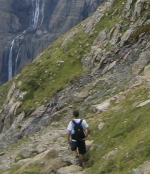 |
Présentation / Lecture
Sounding The Place Out: Exploring Acoustic Environments
I will begin by speculating a geography of the ear. Research conducted between anthropology, sound art and sociology maps out a potential conceptual field in which the perceptual prominence of the visual fades away – at least temporarily – to enable the sensory register of sound to be listened to and learnt from.
With the thematic context established, I will explore three recent projects with which I have been involved.
pdf presentation (download)
back to programme
Interventions précédentes et récentes / Previous and recent lectures
 écoute/listen mp3 Déjà Entendu: Some Thoughts on Sound and its Representation (symposium 4 Extranautes, 2007) écoute/listen mp3 Déjà Entendu: Some Thoughts on Sound and its Representation (symposium 4 Extranautes, 2007)
Angus Carlyle works at the University of the Arts, London where, with Dr. Cathy Lane, he is a Director of CRiSAP.
He has been an intermittent writer for a couple of decades, tackling subjects as diverse as the suicide of Guy Debord and long-distance truck drivers. He has devoted a lot of words to contemporary photography, a process that began when he was the editor of themepark - a magazine that was active across the turn of the millennium – and then continued with texts for gallery catalogues and articles for Hotshoe, Photoworks, Black Dog Press and Eyemazing. He edited Autumn Leaves: Sound and Environment in Artistic Practice for Double Entendre and will soon publish Katch 23, a book about the art-pop band, The KLF.
In recent years, he has been exploring sound in artistic contexts, exhibiting at the DCA Gallery in Tucson, the Zeppelin Festival in Barcelona, in the High Desert Test Sites in Joshua Tree Valley, at London’s E:vent Gallery, on Resonance FM and on the M25 Motorway. He has performed as part of improvising groups in the UK’s oldest cinema, at the Placard Festival and at the Sonic Arts’ Network’s Expo 2008. A CD of his Kami-Katsura recordings will be released by Gruenrekorder in the Spring of 2009. He is a researcher on the multi-disciplinary Positive Soundscape Project.
|
| |
--> http://www.crisap.org/
--> http://www.positivesoundscapes.org/
--> http://www.finetuned.org/
--> http://www.vibrofiles.com/essays_autumn_leaves.php
|
| |
|
Alejo Duque
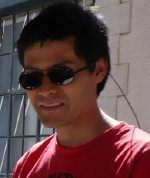 |
Présentation / Lecture (via Skype)
Locus Sonus as a research lab from the perspective
of the streambox development (FLOSS)
My topics will be Locus Sonus as a research lab from the perspective
of the streambox development (FLOSS), then I will like to cover the
community network side of the stream map project and tie in some links
to the event in Amsterdam (http://networkcultures.org/wpmu/
wintercamp/) and finish introducing the project im actually writing to
develop in Colombia that involves pirtate TV but hopes to have Locus
Sonus also onboard.
pdf presentation (download)
back to programme
With a background in video Alejandro Duque is a colombian artist graduated from the school of fine arts of Medellin in Colombia in 1998. He actually pursues a PhD on philosophy of communication at the EGS (European Graduate School http://www.egs.edu/ Switzerland) and his dissertation topic deals with finding ways for smuggling ideas across different networks, "trafficking" concepts crossing marginalized communities and western philosophies. He's member of the Locus Sonus Lab.
Alejandro Duque est un artiste colombien diplômé de l'École d'Art de Medellin en Colombie. Il est actuellement doctorant en thèse de Philosophie de la Communication en Suisse à l'EGS (European Graduate School http://www.egs.edu, Switzerland) et membre du laboratoire Locus Sonus. Sa recherche traite du piratage et de la manière dont les idées sont pillées sur les réseaux (sociaux, internet..) et comment des concepts de communautés marginales sont détournées et confrontées aux philosophies du monde occidental.
|
| |
--> http://co.lab.cohete.net/
|
| |
|
Alain Renaud
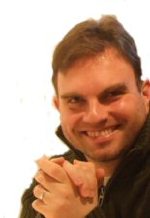 |
Présentation / Lecture
Connected Spaces and Acoustic Morphings
The presentation explores several paradigms related to the development of network
music performance. The presentation focuses on several streams:
• The experience of real time network music performance over the last four
years as part of the Disparate Bodies1 series and the NetVs.Net2 collective.
• The work being undertaken to cue the network to allow more interactive
participation between geographically displaced performers through the
development of audio/visual cueing mechanisms.
• The use of the network to combine scattered acoustical spaces and the
possibility to navigate acoustically though the spaces using a technique known
as “acoustic morphings”
• Network performances and combined acoustic spaces as an opportunity to
develop a specific style that couldn’t happen outside of a networked situation.
pdf presentation (download)
back to programme
Alain Renaud is originally from Geneva, Switzerland. After several years working as a
sound engineer and music industry consultant, he embarked on a PhD. in network
music performance at the Sonic Arts Research Centre (SARC) at Queen's University
Belfast in 2005. Alain has recently been appointed as a lecturer at Bournemouth
University in the southwest of England.
His research focuses on the development of networked music performance systems
with an emphasis on the creation of strategies to interact over a network musically and
the notion of shared networked acoustic spaces. Alain has published several papers on
the subject and has organised various events to introduce networked music performance
to the general public. He has been involved in many network music performances in
Europe and North America. He has also been invited to present his research in various
places such as Banff in Canada and Stanford University in the US, where he was
invited as a visiting scholar in the spring of 2007.
Alain is one of the founders of the NetVs.Net music collective, a group which
produces, records and performs music only over high-speed networks. He is also
involved in the EU network performance project, CoMeDia, which is led by IRCAM in
Paris.
In addition, Alain has been involved in music production for a number of years and has
been working as a producer for the Montreux Jazz Festival since 1999. He is also a
keen electronic music composer/performer and a member of the Audio Engineering
Society (AES).
He completed his BA in Audio Engineering in California in 2001 and his MSc. in
Music Information Technology at City University in London in 2004.
|
| |
-->
http://www.sarc.qub.ac.uk/pages/db/
-->
http://www.alainrenaud.net
|
| |
|
Pedro Soler
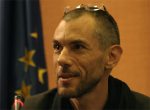 |
Présentation / Lecture
pdf presentation (download)
back to programme
Pedro Soler (Singapore, 1967) has been the director of Barcelona's arts production centre Hangar since December 2005. The centre's objective is to provide means and resources to visual artists. Hangar offers specialized editing suites, two film sets, equipment hire, production consultancy, workshops and grants for artists. The centre is financed with public money (The regional government of Catalonia, Barcelona’s local council, Ministry of Culture, Barcelona’s provincial council) and the Foundation Banc de Sabadell.
Through its International Exchange Programme, Hangar lays out procedures for collaborating with art centres all over the world, both in terms of residency exchanges and in its willingness to participate in joint research and creative experimentation projects.
The programme seeks to promote artists’ mobility so that they may have the opportunity to develop their work in research, creation and production areas in specialized production centres. Contact and interaction in a different setting favours the artistic working process.
Diplomé de l'Universitat Pompeu Fabra (Barcelone) en arts numériques, il travaille avec la vidéo et le son en temps réel, spécialement au théâtre, et participe au développement du logiciel Mirage (sourceforge.net/projects/mirage). Il a été invité dans des festivals de multimédia à travers le monde - de Rotterdam à Bogota en passant par Barcelone.
Hangar est un centre pour la création artistique situé à Barcelone dans le quartier de Poblenou, installé dans un bâtiment industriel remis à neuf recouvrant 1800 m2.
Hangar a plusieurs fonctions mais elles sont toutes gérées dans un but identique : offrir un soutien pour les nouvelles générations d’artistes, quelque soit la nature de leur travail et quels que soient les outils utilisés pour le produire.
Les trois principaux services fournis à la communauté artistique locale sont : la location d’espaces (studios) à des prix très convenables, l’accès à l’équipement, aux programmes et aux techniciens qualifiés, spécialisés dans la création, utilisant les technologies digitales et enfin, les échanges internationaux et les résidences pour artistes.
Hangar permet une marge de liberté aux artistes qui organisent des projets comme Show Rooms, All Open, des programmes vidéo et des expositions.
|
| |
-->
http://root.ps/
-->
http://hangar.org/drupal/
|
| |
|
Ragnar Helgi Olafsson
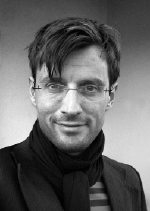 |
Présentation / Lecture
Neither Here Nor There:
A Few Thoughts On Eavesdropping, Locative Media & Some Other Stuff
The two basic issues I would like to take up in the presentation are :
• a) the concept of privacy [public/private space] and eavesdropping as it pertains to streaming audio.
• b) the ideas of location, locative media and non-fixed positioning.
These are issues that have been invoked by our participation in the Locustream-project and by our other interest in the field of networked media.
pdf presentation (download)
back to programme
Ragnar Helgi Olafsson studied philosophy at the University of Iceland from 1991-1997. Moving to France, he graduated from l'Ecole des Beaux Arts d'Aix-en-Provence in 2001. After studying film direction and making narrative short films and animations he now works chiefly with audio and video in installations and internet based art, his work often revolving around the themes of participatory narrativity, time and memory.
Ragnar has recently exhibited his work at KIASMA: The Museum of Contemporary Art [Helsinki, Finland], The Museum of Contemporary Art [Roskilde, Denmark], The National Gallery of Iceland [Reykjavik, Iceland], La Villette Numerique [Paris, France], STEIM [Amsterdam, The Netherlands] and Möbius International [Montréal, Canada]. He is now preparing a piece for Hafnarhus – The Museum of Contemporary Art [Reykjavik, Iceland].
He lives and works in Reykjavik. He also does graphic design work, works as a musician and teaches at Iceland Academy of the Arts.
|
| |
-->
http://wwww.webwaste.net/
|
| |
|
Julien Clauss
 |
Présentation / Lecture
Toposone : performances de champ libre
TOPOSONE est une performance réaliseée dans des sites naturels ou dans des espaces publics
urbains. Trois aà cinq performeurs équipés chacun d'un dispositif de diffusion sonore portable et
connectés via un reéseau sans fil parcourent un site. Chacun syntheétise et modèle des sons qu'il
diffuse et spatialise sur l'ensemble des dispositif embarqués. Ils créent ensemble une sculpture
sonore de grande dimension qui s'inscrit visuellement et acoustiquement dans le site dans
lequel ils évoluent.
Cette étendue sonore formée de sons en mouvement couvre une esplanade, un carrefour, s'étend
du haut d'un immeuble jusqu'à l'extrémité d'une place, se concentre sur une portion de rue, se
déploie sur un stade de quartier ou un terrain vague. Toposone est une forme sonore nomade
jouée à l'échelle d'un site. Elle peut s'apparenter à une sculpture ou à un mobile dont les
éléments en équilibre ne seraient pas matériels mais purement sonores : différents sons sont
déployés dans l'espace environnant puis mis en équilibre et en mouvement les uns avec les
autres pour créer une occupation discrète, cinétique et spatiale dans l'environnement.
pdf presentation (download)
back to programme
Julien Clauss French sound artist has followed the course at the Suzuki Institute of Strasbourg and subsequently worked in various forms of improvised music. Since 2001, he has developed sound works, installations and performances which put at stake the materiality and the spatial dimensions of sound. He is seeking how to physically engage the listener in the act of listening in sound spaces that allow multiple experiences of perception. He's actually member of the Locus Sonus Lab.
Julien Clauss est un artiste français. Après une licence de mécanique des fluides et une maîtrise de technologie mécanique, il étudie l'acoustique au Conservatoire National des Arts et Métiers de Paris. Le travail de Julien Clauss interroge de façon récurrente la perception de l'espace et la place de l'homme dans son environnement. En mettant en jeu la matérialité et la dimension spatiale du son, il engage physiquement l'auditeur dans les processus d'écoute. Il est actuellement membre du laboratoire Locus Sonus.
|
| |
-->
http://www.cycliq.org/
|
|
